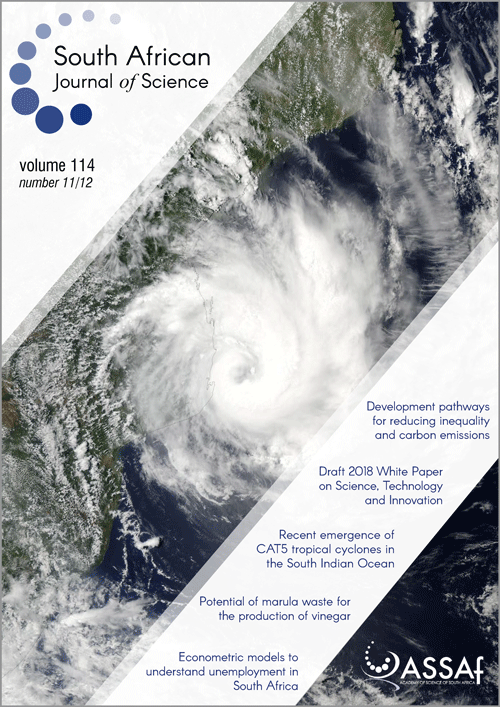Potential of marula (Sclerocarya birrea subsp. caffra) waste for the production of vinegar through surface and submerged fermentation
DOI:
https://doi.org/10.17159/sajs.2018/4874Keywords:
acetic fermentation, commercialisation, fruit, high quality, sensory attributesAbstract
Although there is an abundance of indigenous fruits in South Africa, knowledge of their potential uses is mainly restricted to within communities. In this study, marula fruit-processing waste by-products (fruit pulp residue and skin) were used as substrates in surface culture and submerged fermentation methods to produce vinegar (acetic acid) using spontaneous and starter culture techniques. The study revealed the possibility of producing vinegar through both methods of fermentation, with yields of acetic acid ranging between 41 000 mg/L and 57 000 mg/L (surface culture method) and between 41 000 and 54 000 mg/L (submerged culture method). Furthermore, the physicochemical property analyses revealed marula vinegar to be a potential source of bioactive compounds (total phenolics 0.289–0.356 mg/L GAE and total flavonoids 0.146–0.153 mg/L CAE) which displayed a potent antiradical activity against DPPH•: 78.85% for surface culture and 73.03% submerged culture, respectively. The sensory panel recommended application of the vinegar in products such as salad dressing and mayonnaise. Finally, we have demonstrated that the surface culture method using the inoculation technique is more suitable for the production of high-quality vinegar, with possible consideration for commercialisation.
Significance:
- Marula fruit has high economic importance for South Africa, particularly for the Limpopo Province.
- Marula waste can be a source of bioactive compounds, yet comparatively little is reported on the potential use of the waste to produce vinegar.
- Self-development of communities through viable and easy to produce commodities from marula fruit needs to be implemented and prioritised in the Limpopo Province.
Published
Issue
Section
License

All articles are published under a Creative Commons Attribution 4.0 International Licence
Copyright is retained by the authors. Readers are welcome to reproduce, share and adapt the content without permission provided the source is attributed.
Disclaimer: The publisher and editors accept no responsibility for statements made by the authors
How to Cite
- Abstract 1201
- PDF 1652
- EPUB 207
- XML 403













.png)